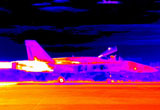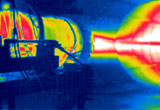Thermal Imaging for Research & Development
In Research & Development and product/process testing, accuracy and reliability are vitally important. FLIR’s SC-Series IR cameras are used for capturing and recording thermal distribution and variations in real time, allowing engineers to see and accurately measure heat patterns, dissipation, leakage, and other temperature factors in equipment, products and processes.
That’s why FLIR infrared cameras are widely used around the world for applications as diverse as micro-electronics, paper processing, automotive, plastics, injection molding, consumer appliance design, telecommunications, target heat signatures, mechanical testing, R&D and much more.
Education & Research Inst.
FLIR infrared cameras are being used in university laboratories where high-end academic and applied research is on-going on a wide range of disciplines. They are also used by university professors as a practical support to their classes.
.jpg)

Measure Heat Transfer Mechanisms
FLIR infrared cameras make accurate non-contact temperature measurements on a wide range of objects. For every situation characterized by a heat transfer mechanism, may it be conductive, convective, or radiative, FLIR infrared cameras are used for quantitative and/or qualitative evaluation on research projects, from swirling flow dynamics to the thermo-mechanical behaviour of composite structures.
Because of their dramatic visual presentation of heat energy and temperature, IR cameras strongly reinforce the learning process. Their use is limited only by an instructor’s imagination.
Target Signature


FLIR infrared cameras are combined with sophisticated software to measure, characterize, or otherwise describe phenomena such as distance to a target object, its size, shape, inherent heat energy, and of course, temperature.
Range phenomenology or Target Signature, as it applies to thermal cameras, involves their use to solve complex engineering problems that go beyond the simple detection of heat sources and their temperatures.
Shorter the time to market
Generally, this requires high levels of sensitivity and accuracy, which are available in FLIR’s cameras using advanced sensor technologies, some of which are cooled. Such camera technology is combined with sophisticated software to measure, characterize, or otherwise describe phenomena such as distance to a target object, its size, shape, inherent heat energy, and of course, temperature.
Some specific applications, particularly in the military/aerospace communities include target recognition and detection, infrared counter measures, plume and atmospheric phenomenology, and various types of non-destructive testing.
Engineering

IR cameras made by FLIR have become indispensible tools for many engineering disciplines, particularly in product development. A prime example is making sure that products do not have excessive heat dissipation that would shorten their useful lives. This applies to both electrical and mechanical components and assemblies.
Shorter the time to market
Studying the heat generation and dissipation of a product at its early stage of development reduces the design iterations and therefore dramatically shorten the time to market of a product. Products are better designed and optimized improving their reliability, safety and cost. Almost all type of product gets benefit of thermal analysis done by infrared images, from tires to complex electronic assembly, from low cost to high technology devices.
Thermal behavior over time
Infrared cameras from FLIR allow measuring a steady temperature pattern as well as thermal evolution over time, even as fleeting as a spark or air bag deployment. Powerful but comprehensive software, which gives access to extended analyses and reporting tools, improves the communication across the different teams.
Stress field measurement
Because of its unique capability of acquiring a thermal snapshot of a material, it is possible to actually see its thermo mechanical properties. It is very useful to evaluate the amount of stress that a mechanical part has to support and then optimize its design to improve its reliability. The fatigue of the material can also be measured allowing predicting much before it occurs where the part will break. The automotive industry takes a dramatic advantage of these possibilities.
Manufacturing Industries

Thermal imaging is widely used in manufacturing industries for a large spectrum of applications. It helps adjusting the process parameters, find non-destructively defects on material without any contact or improve the quality control plan.
Temperature Control System for the Process Industry
In process industries, heat energy is applied in various ways to promote and control production processes, optimize output, and assure product quality. IR cameras are frequently used for non-contact measurements as part of automated temperature control systems for these processes. Some examples are the monitoring and control of chemical reactions, paper mill drying times, artificial fiber drawing operations, glass production and forming, plastic injection molding, primary metal production, die casting operations, laser welding and a host of other processes.
Accurate Non-Contact Temperature Measurements
FLIR’s IR camera systems make accurate non-contact temperature measurements, communicate that data to various departments within the enterprise, and initiate control functions when needed. The need for heat energy and controlled temperatures is nearly universal in manufacturing enterprises. Therefore, the applications for FLIR cameras are extensive.
Material Evaluation & Testing
Infrared is also widely used for non destructive testing or material performance evaluation. Thermal imaging is used by Sodar cells manufacturers, semiconductor foundries to validate the quality of their production.
